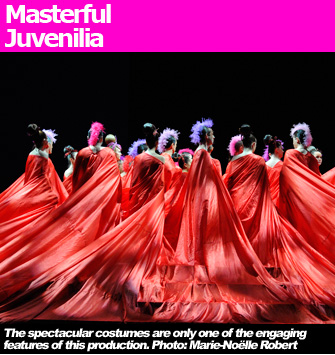
A performance of an early work by a composer or playwright often promises much but delivers little. Several years ago, I was filled with excitement at the prospect of seeing Wagner’s second …

A performance of an early work by a composer or playwright often promises much but delivers little. Several years ago, I was filled with excitement at the prospect of seeing Wagner’s second opera, Das Liebesverbot (Forbidden Love), at the Wexford Opera Festival in Ireland. Apart from the authentically Wagnerian title, the opera turned out to be nothing more than Italianate froth, and it was impossible to discern any of the genius evident in The Flying Dutchman, Tannhauser, Lohengrin, Mastersingers, the Ring cycle, Tristan and Isolde and Parsifal.
I therefore approached the viewing of the Théâtre du Châtelet’s new production of Die Feen (The Fairies), Wagner’s first completed opera, written when he was only 20, with sagely skeptical caution. After all, if the second opera was all froth, surely the first would be little more than airy-fairy nonsense?
How wrong can one be! Die Feen, which was never produced in the composer’s lifetime, turns out to be the young Wagner’s first attempt at writing an authentically German opera, following the model of the illustrious early-19th-century operas by Carl-Maria von Weber and Beethoven. On the whole, it is a musical and dramatic treat, winningly presented in this engaging production conducted by Marc Minkowski and directed by Emilio Sagi.
Wagner is certainly much more at ease with a Germanic musical idiom, and when he failed to get this first work performed, it is probable that he tried his hand at other styles, which proved to be disastrous in Das Liebesverbot. In Die Feen, however, we find not only a musical foretaste of what was to come but also many of the themes that would be crucial to his later works, such as immortality, renunciation and the importance of a curse.
Before I get too carried away by hailing this work as Wagner’s first masterpiece, it must be said that he was still trying to find his musical voice. Die Feen is made up of a hodgepodge of different musical genres; some characters seem to sing in a Germanic style while others remain rooted in Italian traditions. In some cases, such as the fiendishly difficult main tenor role of Arindal (sung heroically and with the occasionally understandable difficulty by the American singer William Joyner), the singers have to change their styles midway through the opera. Arindal starts as a robust heldentenor in training and ends by having to sing in a gently lyrical idiom.
Yet there is also music that is mesmerizing in its intensity, not least the extraordinary unaccompanied choral passage that starts off Act III, beautifully sung by the Choeur des Musiciens du Louvre-Grenoble, excellently trained by the young British chorus master Nicholas Jenkins.
Musically, the absolute star of the evening is the German soprano Christiane Libor, who plays Ada, the fairy who falls in love with the mortal Arindal. Throughout, she sings ravishingly, and it was appropriate that on the first night she received the longest ovation.
All the other singers are strong, especially Lina Tetruashvili as Arindal’s sister Lora, and Laurent Naouiri as Arindal’s servant Gernot.
Minkowski, whom one usually associates with repertoire from the Baroque era, is a wonderful advocate for the music. His direction of the impeccable Musiciens du Louvre-Grenoble was both energetic and sensitive.
As for the production, the colorful costumes are magical and, despite the fact that even the young Wagner never opts for brevity, the pace never slackened.
This production runs in Paris for only a short time, so rush to see this rarely performed yet fascinating early Wagner work. For once, a piece of juvenilia not only promises much but also delivers!
Théâtre du Châtelet: 2, rue Edouard Colonne, 75001. Métro: Châtelet. Tel.: 01 40 28 28 40. Performances: April 1, 4, 7 and 9 at 7:30 p.m. Tickets: up to €10-€120. www.chatelet-theatre.com
Favorite
